University Assignment: Training and Assessment Strategy Implementation
VerifiedAdded on 2023/01/18
|27
|6683
|82
Homework Assignment
AI Summary
This document provides a comprehensive solution to a training and assessment assignment, addressing key aspects of learning strategy implementation. The assignment covers UAT, compliance systems, and organizational learning theories. It examines international e-learning standards, TEQSA framework, and compliance requirements for Registered Training Organizations (RTOs). The solution also explores national standards, technology requirements, and organizational learning theories, including espoused theory and theory in use. Furthermore, it delves into organizational evaluation strategies, the importance of modifying learning strategies in a globalized world, processes for continuous improvement, and the role of communication and stakeholders. The document also discusses assessment instrument design, quality management compliance, and the roles of key figures within an organization, including board members and the CEO. The assignment emphasizes the importance of compliance, quality management, and effective communication for successful learning strategy implementation. The solution is designed to provide a detailed overview of the relevant concepts and practical applications within the field of leadership and management.
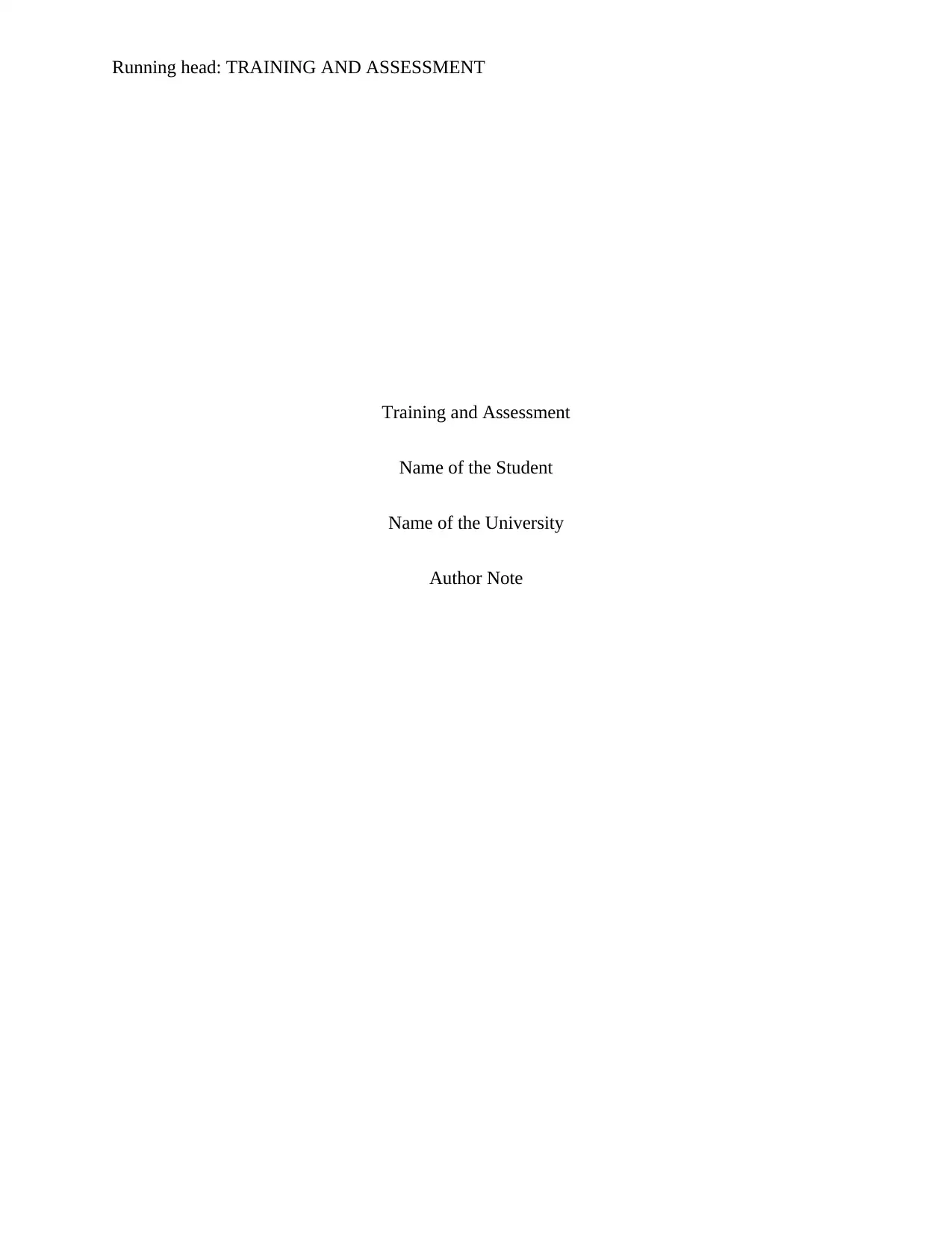
Running head: TRAINING AND ASSESSMENT
Training and Assessment
Name of the Student
Name of the University
Author Note
Training and Assessment
Name of the Student
Name of the University
Author Note
Paraphrase This Document
Need a fresh take? Get an instant paraphrase of this document with our AI Paraphraser
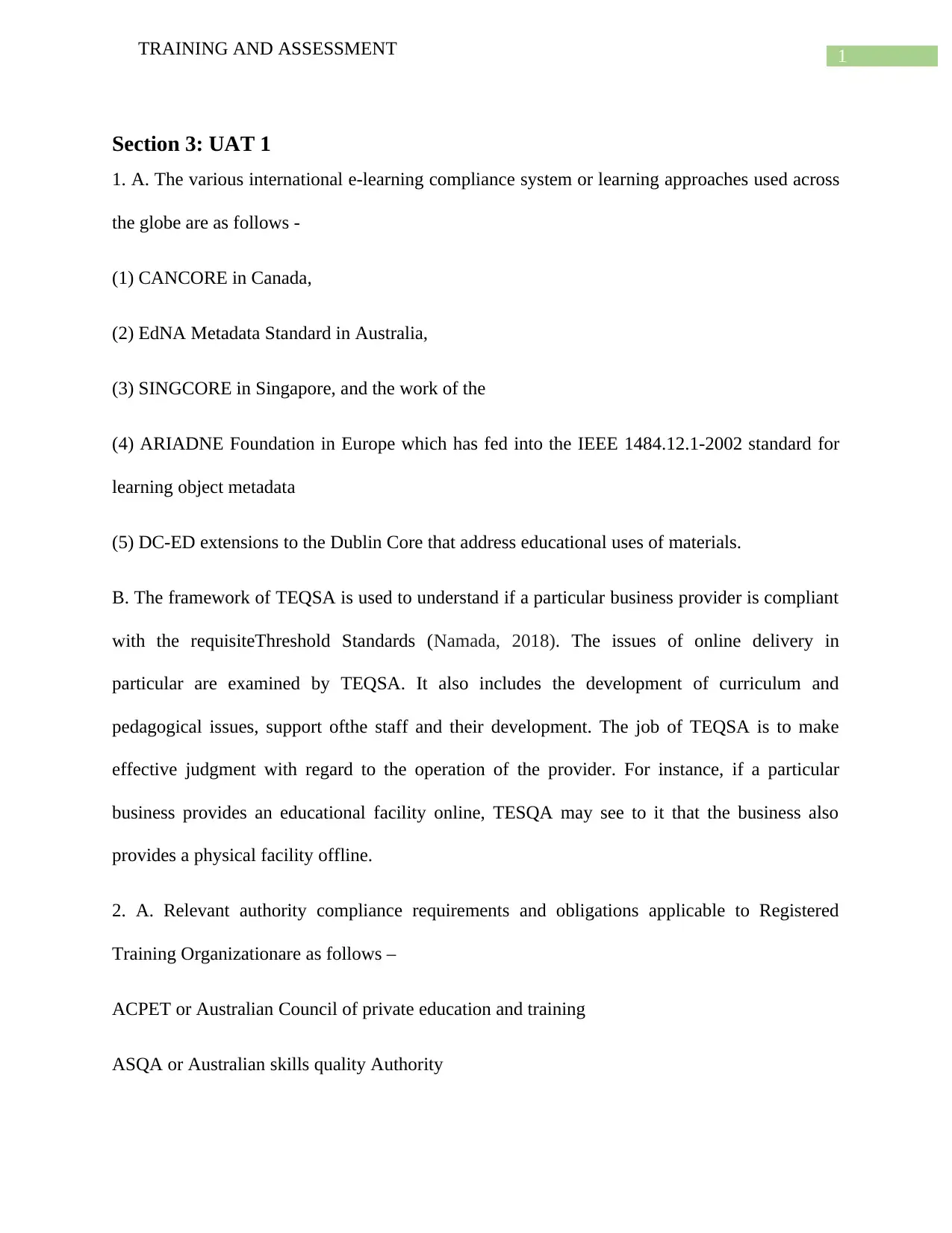
1TRAINING AND ASSESSMENT
Section 3: UAT 1
1. A. The various international e-learning compliance system or learning approaches used across
the globe are as follows -
(1) CANCORE in Canada,
(2) EdNA Metadata Standard in Australia,
(3) SINGCORE in Singapore, and the work of the
(4) ARIADNE Foundation in Europe which has fed into the IEEE 1484.12.1-2002 standard for
learning object metadata
(5) DC-ED extensions to the Dublin Core that address educational uses of materials.
B. The framework of TEQSA is used to understand if a particular business provider is compliant
with the requisiteThreshold Standards (Namada, 2018). The issues of online delivery in
particular are examined by TEQSA. It also includes the development of curriculum and
pedagogical issues, support ofthe staff and their development. The job of TEQSA is to make
effective judgment with regard to the operation of the provider. For instance, if a particular
business provides an educational facility online, TESQA may see to it that the business also
provides a physical facility offline.
2. A. Relevant authority compliance requirements and obligations applicable to Registered
Training Organizationare as follows –
ACPET or Australian Council of private education and training
ASQA or Australian skills quality Authority
Section 3: UAT 1
1. A. The various international e-learning compliance system or learning approaches used across
the globe are as follows -
(1) CANCORE in Canada,
(2) EdNA Metadata Standard in Australia,
(3) SINGCORE in Singapore, and the work of the
(4) ARIADNE Foundation in Europe which has fed into the IEEE 1484.12.1-2002 standard for
learning object metadata
(5) DC-ED extensions to the Dublin Core that address educational uses of materials.
B. The framework of TEQSA is used to understand if a particular business provider is compliant
with the requisiteThreshold Standards (Namada, 2018). The issues of online delivery in
particular are examined by TEQSA. It also includes the development of curriculum and
pedagogical issues, support ofthe staff and their development. The job of TEQSA is to make
effective judgment with regard to the operation of the provider. For instance, if a particular
business provides an educational facility online, TESQA may see to it that the business also
provides a physical facility offline.
2. A. Relevant authority compliance requirements and obligations applicable to Registered
Training Organizationare as follows –
ACPET or Australian Council of private education and training
ASQA or Australian skills quality Authority
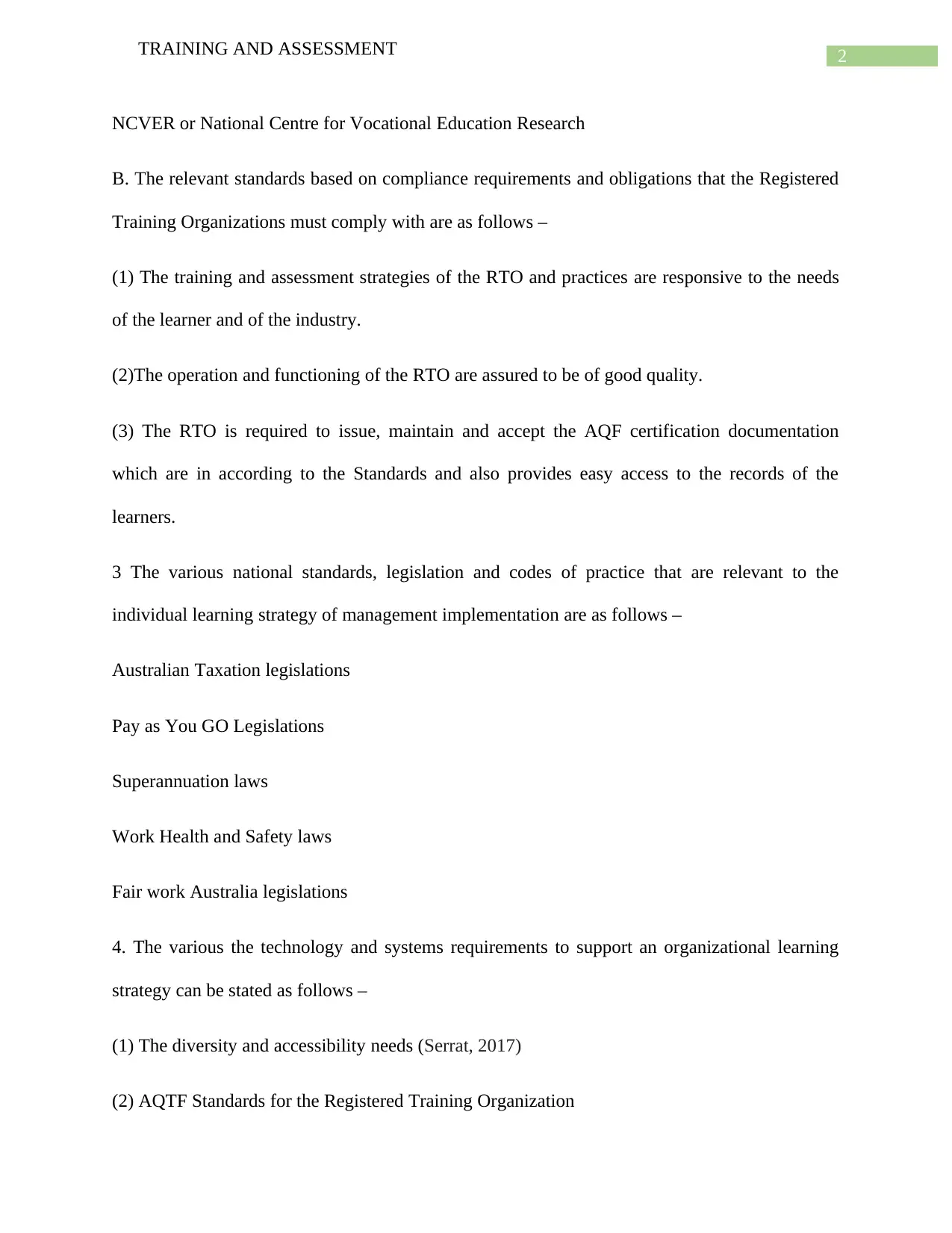
2TRAINING AND ASSESSMENT
NCVER or National Centre for Vocational Education Research
B. The relevant standards based on compliance requirements and obligations that the Registered
Training Organizations must comply with are as follows –
(1) The training and assessment strategies of the RTO and practices are responsive to the needs
of the learner and of the industry.
(2)The operation and functioning of the RTO are assured to be of good quality.
(3) The RTO is required to issue, maintain and accept the AQF certification documentation
which are in according to the Standards and also provides easy access to the records of the
learners.
3 The various national standards, legislation and codes of practice that are relevant to the
individual learning strategy of management implementation are as follows –
Australian Taxation legislations
Pay as You GO Legislations
Superannuation laws
Work Health and Safety laws
Fair work Australia legislations
4. The various the technology and systems requirements to support an organizational learning
strategy can be stated as follows –
(1) The diversity and accessibility needs (Serrat, 2017)
(2) AQTF Standards for the Registered Training Organization
NCVER or National Centre for Vocational Education Research
B. The relevant standards based on compliance requirements and obligations that the Registered
Training Organizations must comply with are as follows –
(1) The training and assessment strategies of the RTO and practices are responsive to the needs
of the learner and of the industry.
(2)The operation and functioning of the RTO are assured to be of good quality.
(3) The RTO is required to issue, maintain and accept the AQF certification documentation
which are in according to the Standards and also provides easy access to the records of the
learners.
3 The various national standards, legislation and codes of practice that are relevant to the
individual learning strategy of management implementation are as follows –
Australian Taxation legislations
Pay as You GO Legislations
Superannuation laws
Work Health and Safety laws
Fair work Australia legislations
4. The various the technology and systems requirements to support an organizational learning
strategy can be stated as follows –
(1) The diversity and accessibility needs (Serrat, 2017)
(2) AQTF Standards for the Registered Training Organization
⊘ This is a preview!⊘
Do you want full access?
Subscribe today to unlock all pages.

Trusted by 1+ million students worldwide
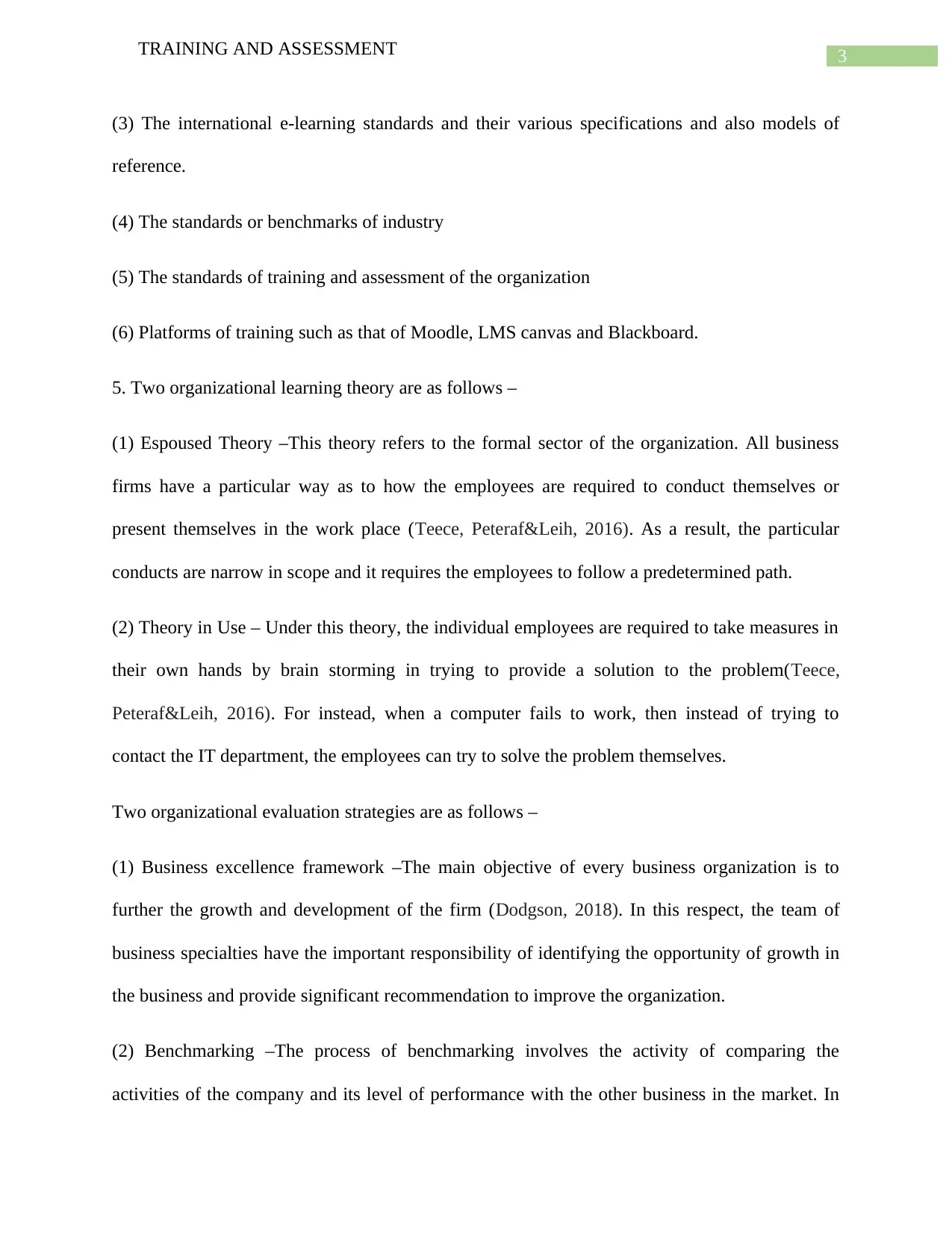
3TRAINING AND ASSESSMENT
(3) The international e-learning standards and their various specifications and also models of
reference.
(4) The standards or benchmarks of industry
(5) The standards of training and assessment of the organization
(6) Platforms of training such as that of Moodle, LMS canvas and Blackboard.
5. Two organizational learning theory are as follows –
(1) Espoused Theory –This theory refers to the formal sector of the organization. All business
firms have a particular way as to how the employees are required to conduct themselves or
present themselves in the work place (Teece, Peteraf&Leih, 2016). As a result, the particular
conducts are narrow in scope and it requires the employees to follow a predetermined path.
(2) Theory in Use – Under this theory, the individual employees are required to take measures in
their own hands by brain storming in trying to provide a solution to the problem(Teece,
Peteraf&Leih, 2016). For instead, when a computer fails to work, then instead of trying to
contact the IT department, the employees can try to solve the problem themselves.
Two organizational evaluation strategies are as follows –
(1) Business excellence framework –The main objective of every business organization is to
further the growth and development of the firm (Dodgson, 2018). In this respect, the team of
business specialties have the important responsibility of identifying the opportunity of growth in
the business and provide significant recommendation to improve the organization.
(2) Benchmarking –The process of benchmarking involves the activity of comparing the
activities of the company and its level of performance with the other business in the market. In
(3) The international e-learning standards and their various specifications and also models of
reference.
(4) The standards or benchmarks of industry
(5) The standards of training and assessment of the organization
(6) Platforms of training such as that of Moodle, LMS canvas and Blackboard.
5. Two organizational learning theory are as follows –
(1) Espoused Theory –This theory refers to the formal sector of the organization. All business
firms have a particular way as to how the employees are required to conduct themselves or
present themselves in the work place (Teece, Peteraf&Leih, 2016). As a result, the particular
conducts are narrow in scope and it requires the employees to follow a predetermined path.
(2) Theory in Use – Under this theory, the individual employees are required to take measures in
their own hands by brain storming in trying to provide a solution to the problem(Teece,
Peteraf&Leih, 2016). For instead, when a computer fails to work, then instead of trying to
contact the IT department, the employees can try to solve the problem themselves.
Two organizational evaluation strategies are as follows –
(1) Business excellence framework –The main objective of every business organization is to
further the growth and development of the firm (Dodgson, 2018). In this respect, the team of
business specialties have the important responsibility of identifying the opportunity of growth in
the business and provide significant recommendation to improve the organization.
(2) Benchmarking –The process of benchmarking involves the activity of comparing the
activities of the company and its level of performance with the other business in the market. In
Paraphrase This Document
Need a fresh take? Get an instant paraphrase of this document with our AI Paraphraser
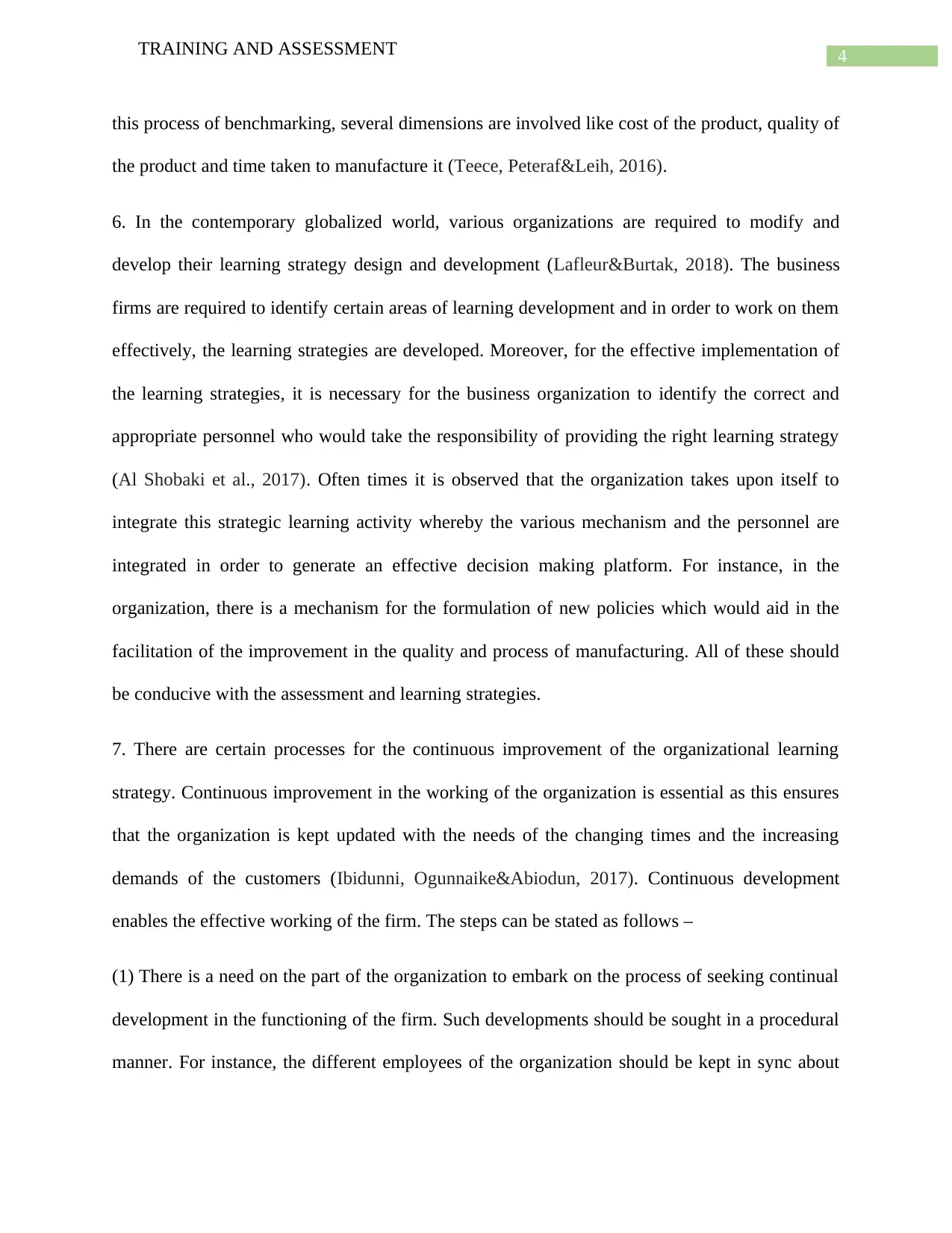
4TRAINING AND ASSESSMENT
this process of benchmarking, several dimensions are involved like cost of the product, quality of
the product and time taken to manufacture it (Teece, Peteraf&Leih, 2016).
6. In the contemporary globalized world, various organizations are required to modify and
develop their learning strategy design and development (Lafleur&Burtak, 2018). The business
firms are required to identify certain areas of learning development and in order to work on them
effectively, the learning strategies are developed. Moreover, for the effective implementation of
the learning strategies, it is necessary for the business organization to identify the correct and
appropriate personnel who would take the responsibility of providing the right learning strategy
(Al Shobaki et al., 2017). Often times it is observed that the organization takes upon itself to
integrate this strategic learning activity whereby the various mechanism and the personnel are
integrated in order to generate an effective decision making platform. For instance, in the
organization, there is a mechanism for the formulation of new policies which would aid in the
facilitation of the improvement in the quality and process of manufacturing. All of these should
be conducive with the assessment and learning strategies.
7. There are certain processes for the continuous improvement of the organizational learning
strategy. Continuous improvement in the working of the organization is essential as this ensures
that the organization is kept updated with the needs of the changing times and the increasing
demands of the customers (Ibidunni, Ogunnaike&Abiodun, 2017). Continuous development
enables the effective working of the firm. The steps can be stated as follows –
(1) There is a need on the part of the organization to embark on the process of seeking continual
development in the functioning of the firm. Such developments should be sought in a procedural
manner. For instance, the different employees of the organization should be kept in sync about
this process of benchmarking, several dimensions are involved like cost of the product, quality of
the product and time taken to manufacture it (Teece, Peteraf&Leih, 2016).
6. In the contemporary globalized world, various organizations are required to modify and
develop their learning strategy design and development (Lafleur&Burtak, 2018). The business
firms are required to identify certain areas of learning development and in order to work on them
effectively, the learning strategies are developed. Moreover, for the effective implementation of
the learning strategies, it is necessary for the business organization to identify the correct and
appropriate personnel who would take the responsibility of providing the right learning strategy
(Al Shobaki et al., 2017). Often times it is observed that the organization takes upon itself to
integrate this strategic learning activity whereby the various mechanism and the personnel are
integrated in order to generate an effective decision making platform. For instance, in the
organization, there is a mechanism for the formulation of new policies which would aid in the
facilitation of the improvement in the quality and process of manufacturing. All of these should
be conducive with the assessment and learning strategies.
7. There are certain processes for the continuous improvement of the organizational learning
strategy. Continuous improvement in the working of the organization is essential as this ensures
that the organization is kept updated with the needs of the changing times and the increasing
demands of the customers (Ibidunni, Ogunnaike&Abiodun, 2017). Continuous development
enables the effective working of the firm. The steps can be stated as follows –
(1) There is a need on the part of the organization to embark on the process of seeking continual
development in the functioning of the firm. Such developments should be sought in a procedural
manner. For instance, the different employees of the organization should be kept in sync about
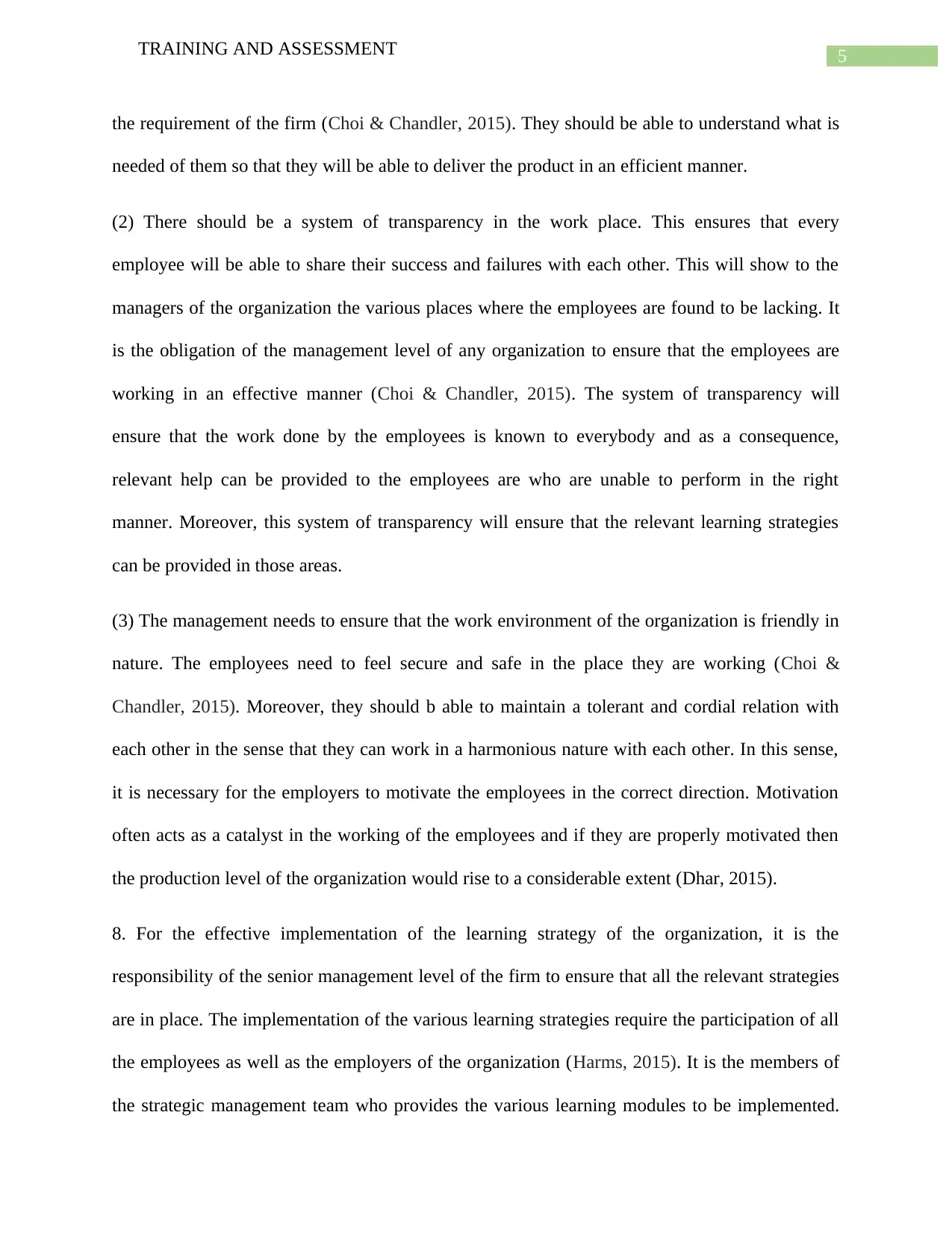
5TRAINING AND ASSESSMENT
the requirement of the firm (Choi & Chandler, 2015). They should be able to understand what is
needed of them so that they will be able to deliver the product in an efficient manner.
(2) There should be a system of transparency in the work place. This ensures that every
employee will be able to share their success and failures with each other. This will show to the
managers of the organization the various places where the employees are found to be lacking. It
is the obligation of the management level of any organization to ensure that the employees are
working in an effective manner (Choi & Chandler, 2015). The system of transparency will
ensure that the work done by the employees is known to everybody and as a consequence,
relevant help can be provided to the employees are who are unable to perform in the right
manner. Moreover, this system of transparency will ensure that the relevant learning strategies
can be provided in those areas.
(3) The management needs to ensure that the work environment of the organization is friendly in
nature. The employees need to feel secure and safe in the place they are working (Choi &
Chandler, 2015). Moreover, they should b able to maintain a tolerant and cordial relation with
each other in the sense that they can work in a harmonious nature with each other. In this sense,
it is necessary for the employers to motivate the employees in the correct direction. Motivation
often acts as a catalyst in the working of the employees and if they are properly motivated then
the production level of the organization would rise to a considerable extent (Dhar, 2015).
8. For the effective implementation of the learning strategy of the organization, it is the
responsibility of the senior management level of the firm to ensure that all the relevant strategies
are in place. The implementation of the various learning strategies require the participation of all
the employees as well as the employers of the organization (Harms, 2015). It is the members of
the strategic management team who provides the various learning modules to be implemented.
the requirement of the firm (Choi & Chandler, 2015). They should be able to understand what is
needed of them so that they will be able to deliver the product in an efficient manner.
(2) There should be a system of transparency in the work place. This ensures that every
employee will be able to share their success and failures with each other. This will show to the
managers of the organization the various places where the employees are found to be lacking. It
is the obligation of the management level of any organization to ensure that the employees are
working in an effective manner (Choi & Chandler, 2015). The system of transparency will
ensure that the work done by the employees is known to everybody and as a consequence,
relevant help can be provided to the employees are who are unable to perform in the right
manner. Moreover, this system of transparency will ensure that the relevant learning strategies
can be provided in those areas.
(3) The management needs to ensure that the work environment of the organization is friendly in
nature. The employees need to feel secure and safe in the place they are working (Choi &
Chandler, 2015). Moreover, they should b able to maintain a tolerant and cordial relation with
each other in the sense that they can work in a harmonious nature with each other. In this sense,
it is necessary for the employers to motivate the employees in the correct direction. Motivation
often acts as a catalyst in the working of the employees and if they are properly motivated then
the production level of the organization would rise to a considerable extent (Dhar, 2015).
8. For the effective implementation of the learning strategy of the organization, it is the
responsibility of the senior management level of the firm to ensure that all the relevant strategies
are in place. The implementation of the various learning strategies require the participation of all
the employees as well as the employers of the organization (Harms, 2015). It is the members of
the strategic management team who provides the various learning modules to be implemented.
⊘ This is a preview!⊘
Do you want full access?
Subscribe today to unlock all pages.

Trusted by 1+ million students worldwide
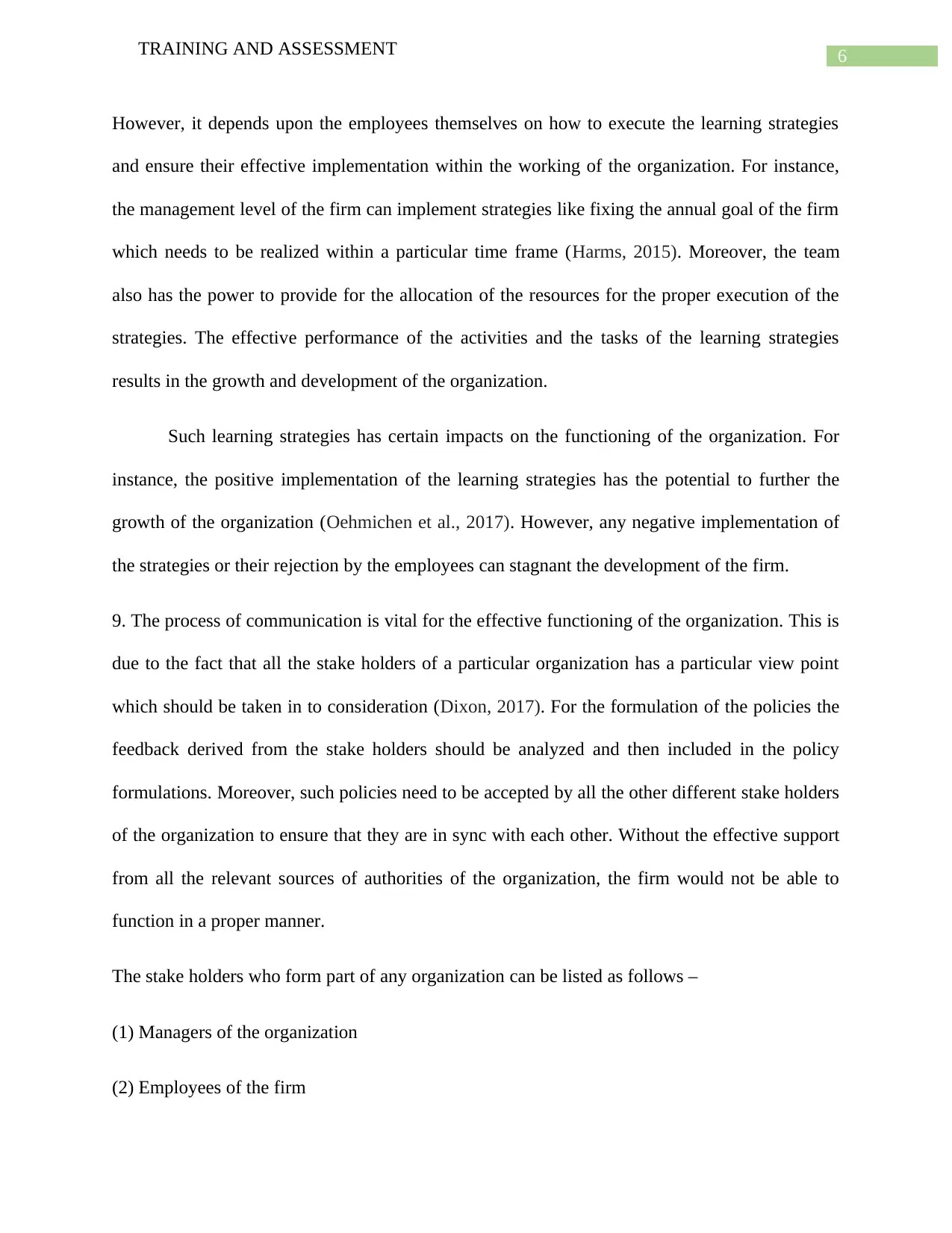
6TRAINING AND ASSESSMENT
However, it depends upon the employees themselves on how to execute the learning strategies
and ensure their effective implementation within the working of the organization. For instance,
the management level of the firm can implement strategies like fixing the annual goal of the firm
which needs to be realized within a particular time frame (Harms, 2015). Moreover, the team
also has the power to provide for the allocation of the resources for the proper execution of the
strategies. The effective performance of the activities and the tasks of the learning strategies
results in the growth and development of the organization.
Such learning strategies has certain impacts on the functioning of the organization. For
instance, the positive implementation of the learning strategies has the potential to further the
growth of the organization (Oehmichen et al., 2017). However, any negative implementation of
the strategies or their rejection by the employees can stagnant the development of the firm.
9. The process of communication is vital for the effective functioning of the organization. This is
due to the fact that all the stake holders of a particular organization has a particular view point
which should be taken in to consideration (Dixon, 2017). For the formulation of the policies the
feedback derived from the stake holders should be analyzed and then included in the policy
formulations. Moreover, such policies need to be accepted by all the other different stake holders
of the organization to ensure that they are in sync with each other. Without the effective support
from all the relevant sources of authorities of the organization, the firm would not be able to
function in a proper manner.
The stake holders who form part of any organization can be listed as follows –
(1) Managers of the organization
(2) Employees of the firm
However, it depends upon the employees themselves on how to execute the learning strategies
and ensure their effective implementation within the working of the organization. For instance,
the management level of the firm can implement strategies like fixing the annual goal of the firm
which needs to be realized within a particular time frame (Harms, 2015). Moreover, the team
also has the power to provide for the allocation of the resources for the proper execution of the
strategies. The effective performance of the activities and the tasks of the learning strategies
results in the growth and development of the organization.
Such learning strategies has certain impacts on the functioning of the organization. For
instance, the positive implementation of the learning strategies has the potential to further the
growth of the organization (Oehmichen et al., 2017). However, any negative implementation of
the strategies or their rejection by the employees can stagnant the development of the firm.
9. The process of communication is vital for the effective functioning of the organization. This is
due to the fact that all the stake holders of a particular organization has a particular view point
which should be taken in to consideration (Dixon, 2017). For the formulation of the policies the
feedback derived from the stake holders should be analyzed and then included in the policy
formulations. Moreover, such policies need to be accepted by all the other different stake holders
of the organization to ensure that they are in sync with each other. Without the effective support
from all the relevant sources of authorities of the organization, the firm would not be able to
function in a proper manner.
The stake holders who form part of any organization can be listed as follows –
(1) Managers of the organization
(2) Employees of the firm
Paraphrase This Document
Need a fresh take? Get an instant paraphrase of this document with our AI Paraphraser
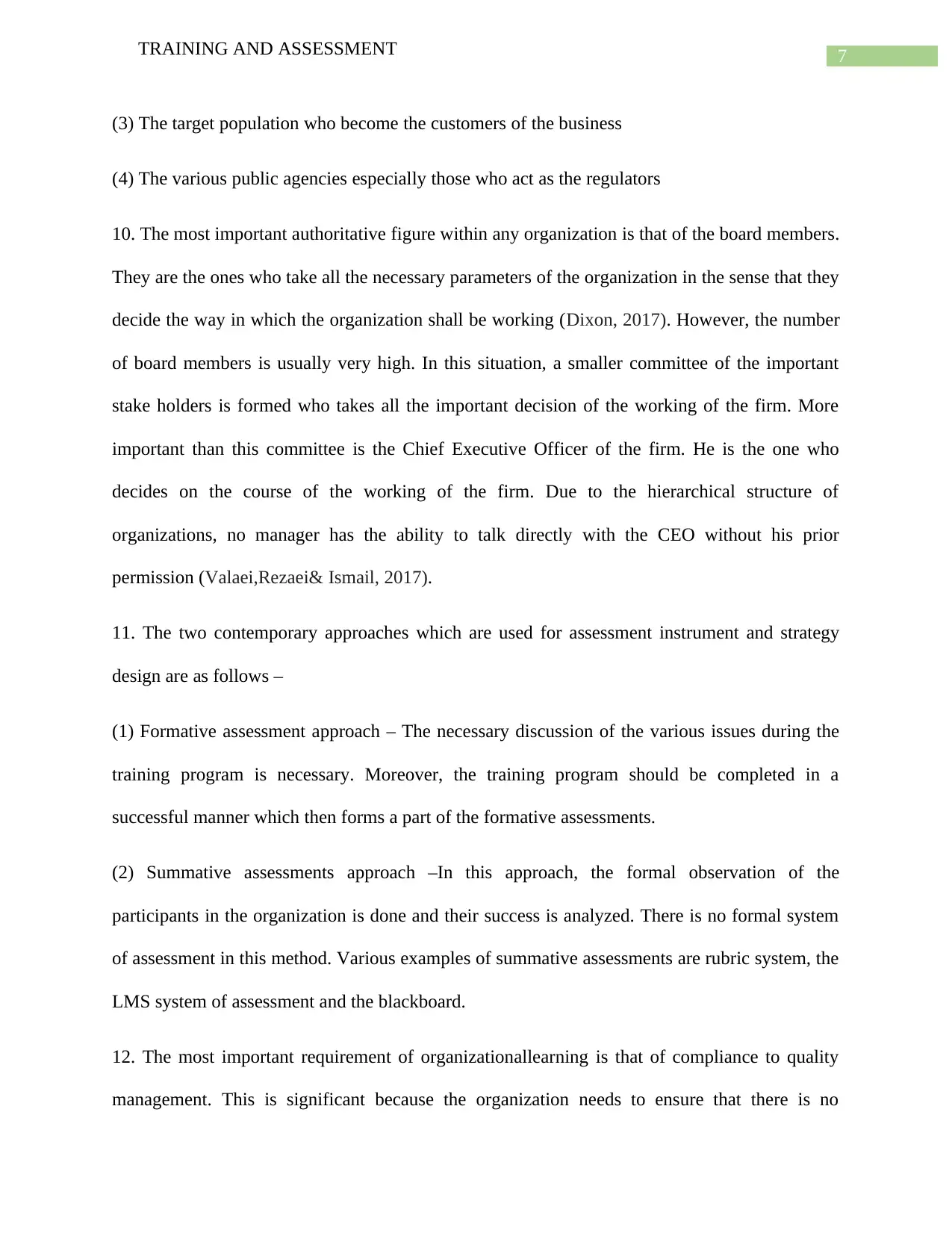
7TRAINING AND ASSESSMENT
(3) The target population who become the customers of the business
(4) The various public agencies especially those who act as the regulators
10. The most important authoritative figure within any organization is that of the board members.
They are the ones who take all the necessary parameters of the organization in the sense that they
decide the way in which the organization shall be working (Dixon, 2017). However, the number
of board members is usually very high. In this situation, a smaller committee of the important
stake holders is formed who takes all the important decision of the working of the firm. More
important than this committee is the Chief Executive Officer of the firm. He is the one who
decides on the course of the working of the firm. Due to the hierarchical structure of
organizations, no manager has the ability to talk directly with the CEO without his prior
permission (Valaei,Rezaei& Ismail, 2017).
11. The two contemporary approaches which are used for assessment instrument and strategy
design are as follows –
(1) Formative assessment approach – The necessary discussion of the various issues during the
training program is necessary. Moreover, the training program should be completed in a
successful manner which then forms a part of the formative assessments.
(2) Summative assessments approach –In this approach, the formal observation of the
participants in the organization is done and their success is analyzed. There is no formal system
of assessment in this method. Various examples of summative assessments are rubric system, the
LMS system of assessment and the blackboard.
12. The most important requirement of organizationallearning is that of compliance to quality
management. This is significant because the organization needs to ensure that there is no
(3) The target population who become the customers of the business
(4) The various public agencies especially those who act as the regulators
10. The most important authoritative figure within any organization is that of the board members.
They are the ones who take all the necessary parameters of the organization in the sense that they
decide the way in which the organization shall be working (Dixon, 2017). However, the number
of board members is usually very high. In this situation, a smaller committee of the important
stake holders is formed who takes all the important decision of the working of the firm. More
important than this committee is the Chief Executive Officer of the firm. He is the one who
decides on the course of the working of the firm. Due to the hierarchical structure of
organizations, no manager has the ability to talk directly with the CEO without his prior
permission (Valaei,Rezaei& Ismail, 2017).
11. The two contemporary approaches which are used for assessment instrument and strategy
design are as follows –
(1) Formative assessment approach – The necessary discussion of the various issues during the
training program is necessary. Moreover, the training program should be completed in a
successful manner which then forms a part of the formative assessments.
(2) Summative assessments approach –In this approach, the formal observation of the
participants in the organization is done and their success is analyzed. There is no formal system
of assessment in this method. Various examples of summative assessments are rubric system, the
LMS system of assessment and the blackboard.
12. The most important requirement of organizationallearning is that of compliance to quality
management. This is significant because the organization needs to ensure that there is no
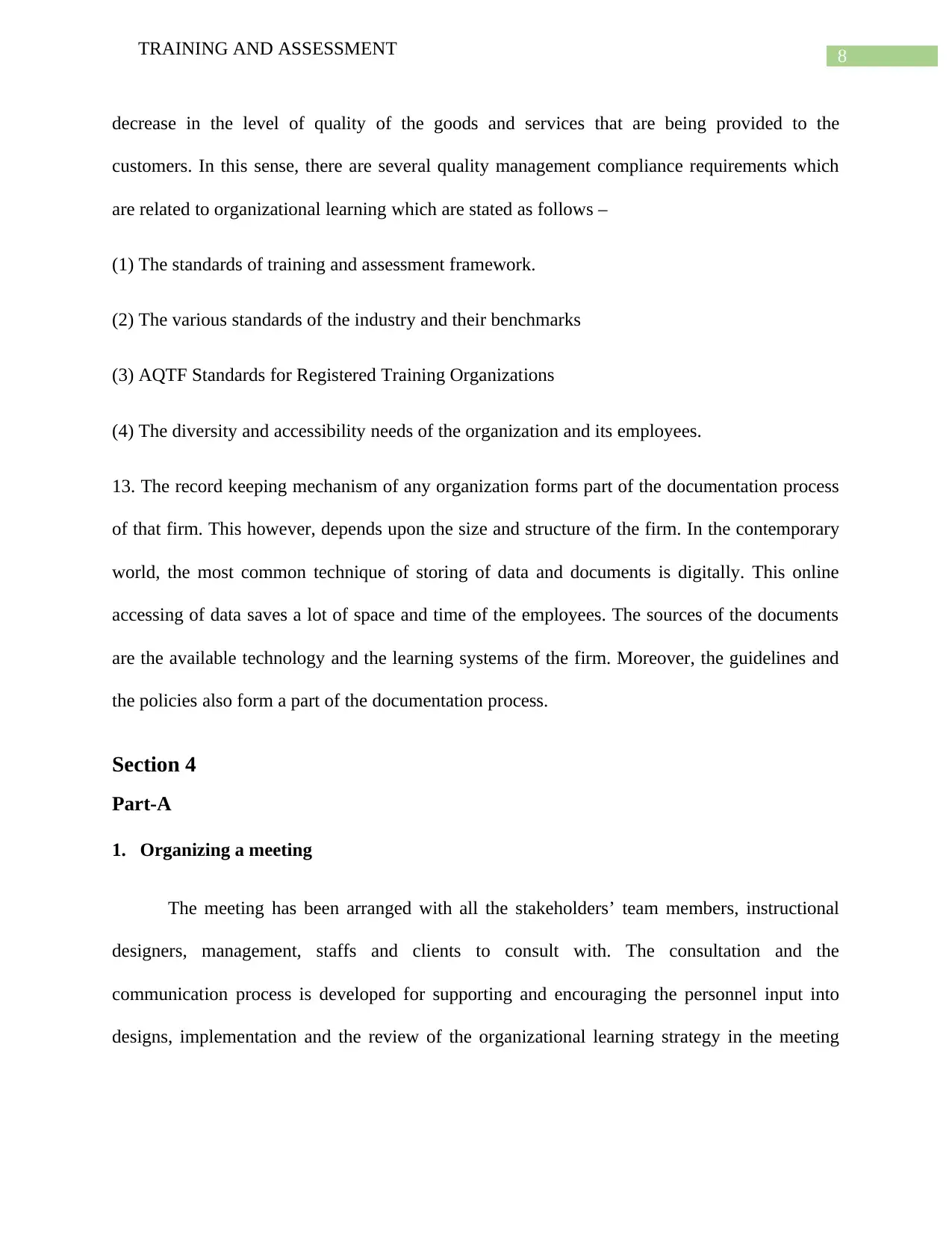
8TRAINING AND ASSESSMENT
decrease in the level of quality of the goods and services that are being provided to the
customers. In this sense, there are several quality management compliance requirements which
are related to organizational learning which are stated as follows –
(1) The standards of training and assessment framework.
(2) The various standards of the industry and their benchmarks
(3) AQTF Standards for Registered Training Organizations
(4) The diversity and accessibility needs of the organization and its employees.
13. The record keeping mechanism of any organization forms part of the documentation process
of that firm. This however, depends upon the size and structure of the firm. In the contemporary
world, the most common technique of storing of data and documents is digitally. This online
accessing of data saves a lot of space and time of the employees. The sources of the documents
are the available technology and the learning systems of the firm. Moreover, the guidelines and
the policies also form a part of the documentation process.
Section 4
Part-A
1. Organizing a meeting
The meeting has been arranged with all the stakeholders’ team members, instructional
designers, management, staffs and clients to consult with. The consultation and the
communication process is developed for supporting and encouraging the personnel input into
designs, implementation and the review of the organizational learning strategy in the meeting
decrease in the level of quality of the goods and services that are being provided to the
customers. In this sense, there are several quality management compliance requirements which
are related to organizational learning which are stated as follows –
(1) The standards of training and assessment framework.
(2) The various standards of the industry and their benchmarks
(3) AQTF Standards for Registered Training Organizations
(4) The diversity and accessibility needs of the organization and its employees.
13. The record keeping mechanism of any organization forms part of the documentation process
of that firm. This however, depends upon the size and structure of the firm. In the contemporary
world, the most common technique of storing of data and documents is digitally. This online
accessing of data saves a lot of space and time of the employees. The sources of the documents
are the available technology and the learning systems of the firm. Moreover, the guidelines and
the policies also form a part of the documentation process.
Section 4
Part-A
1. Organizing a meeting
The meeting has been arranged with all the stakeholders’ team members, instructional
designers, management, staffs and clients to consult with. The consultation and the
communication process is developed for supporting and encouraging the personnel input into
designs, implementation and the review of the organizational learning strategy in the meeting
⊘ This is a preview!⊘
Do you want full access?
Subscribe today to unlock all pages.

Trusted by 1+ million students worldwide
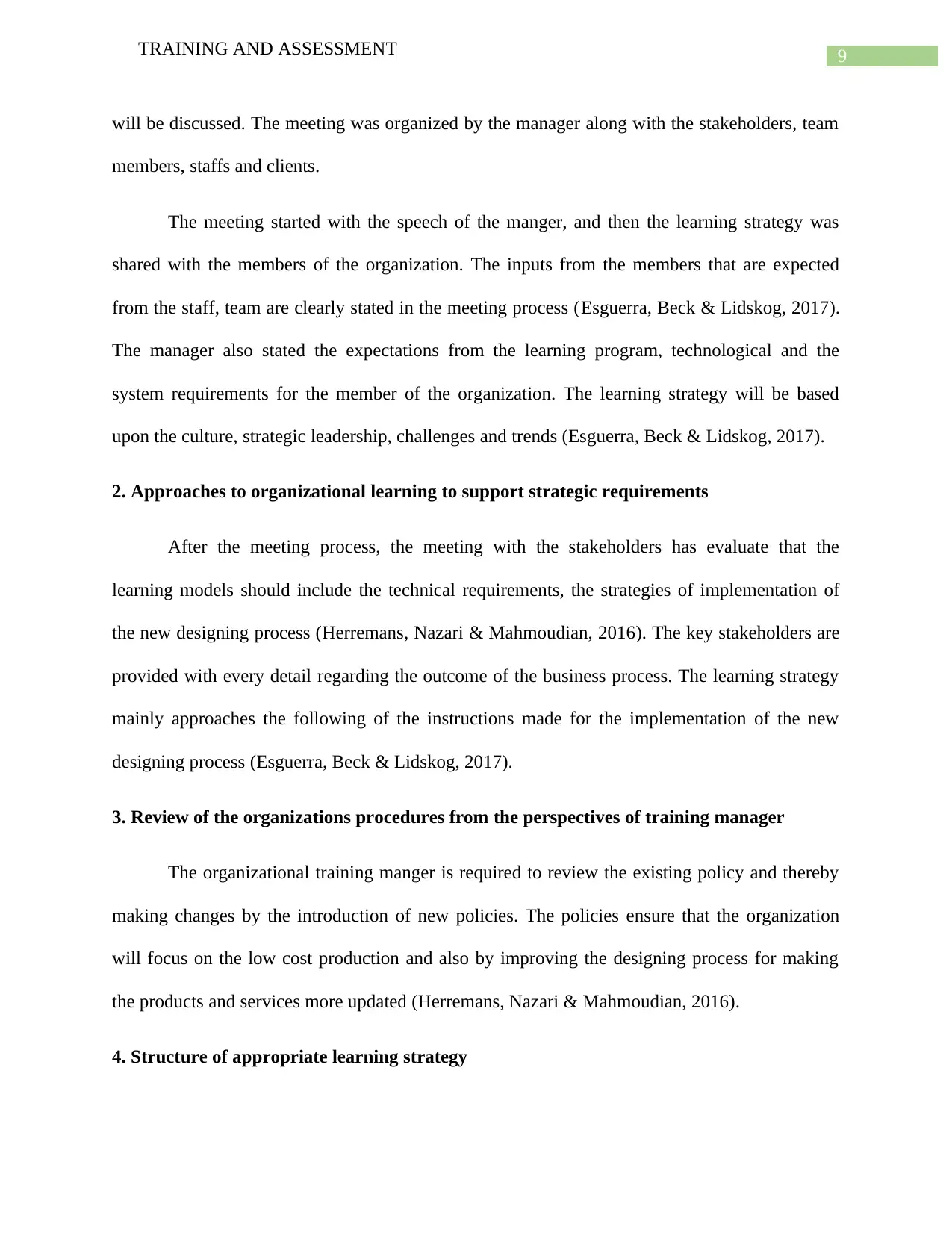
9TRAINING AND ASSESSMENT
will be discussed. The meeting was organized by the manager along with the stakeholders, team
members, staffs and clients.
The meeting started with the speech of the manger, and then the learning strategy was
shared with the members of the organization. The inputs from the members that are expected
from the staff, team are clearly stated in the meeting process (Esguerra, Beck & Lidskog, 2017).
The manager also stated the expectations from the learning program, technological and the
system requirements for the member of the organization. The learning strategy will be based
upon the culture, strategic leadership, challenges and trends (Esguerra, Beck & Lidskog, 2017).
2. Approaches to organizational learning to support strategic requirements
After the meeting process, the meeting with the stakeholders has evaluate that the
learning models should include the technical requirements, the strategies of implementation of
the new designing process (Herremans, Nazari & Mahmoudian, 2016). The key stakeholders are
provided with every detail regarding the outcome of the business process. The learning strategy
mainly approaches the following of the instructions made for the implementation of the new
designing process (Esguerra, Beck & Lidskog, 2017).
3. Review of the organizations procedures from the perspectives of training manager
The organizational training manger is required to review the existing policy and thereby
making changes by the introduction of new policies. The policies ensure that the organization
will focus on the low cost production and also by improving the designing process for making
the products and services more updated (Herremans, Nazari & Mahmoudian, 2016).
4. Structure of appropriate learning strategy
will be discussed. The meeting was organized by the manager along with the stakeholders, team
members, staffs and clients.
The meeting started with the speech of the manger, and then the learning strategy was
shared with the members of the organization. The inputs from the members that are expected
from the staff, team are clearly stated in the meeting process (Esguerra, Beck & Lidskog, 2017).
The manager also stated the expectations from the learning program, technological and the
system requirements for the member of the organization. The learning strategy will be based
upon the culture, strategic leadership, challenges and trends (Esguerra, Beck & Lidskog, 2017).
2. Approaches to organizational learning to support strategic requirements
After the meeting process, the meeting with the stakeholders has evaluate that the
learning models should include the technical requirements, the strategies of implementation of
the new designing process (Herremans, Nazari & Mahmoudian, 2016). The key stakeholders are
provided with every detail regarding the outcome of the business process. The learning strategy
mainly approaches the following of the instructions made for the implementation of the new
designing process (Esguerra, Beck & Lidskog, 2017).
3. Review of the organizations procedures from the perspectives of training manager
The organizational training manger is required to review the existing policy and thereby
making changes by the introduction of new policies. The policies ensure that the organization
will focus on the low cost production and also by improving the designing process for making
the products and services more updated (Herremans, Nazari & Mahmoudian, 2016).
4. Structure of appropriate learning strategy
Paraphrase This Document
Need a fresh take? Get an instant paraphrase of this document with our AI Paraphraser
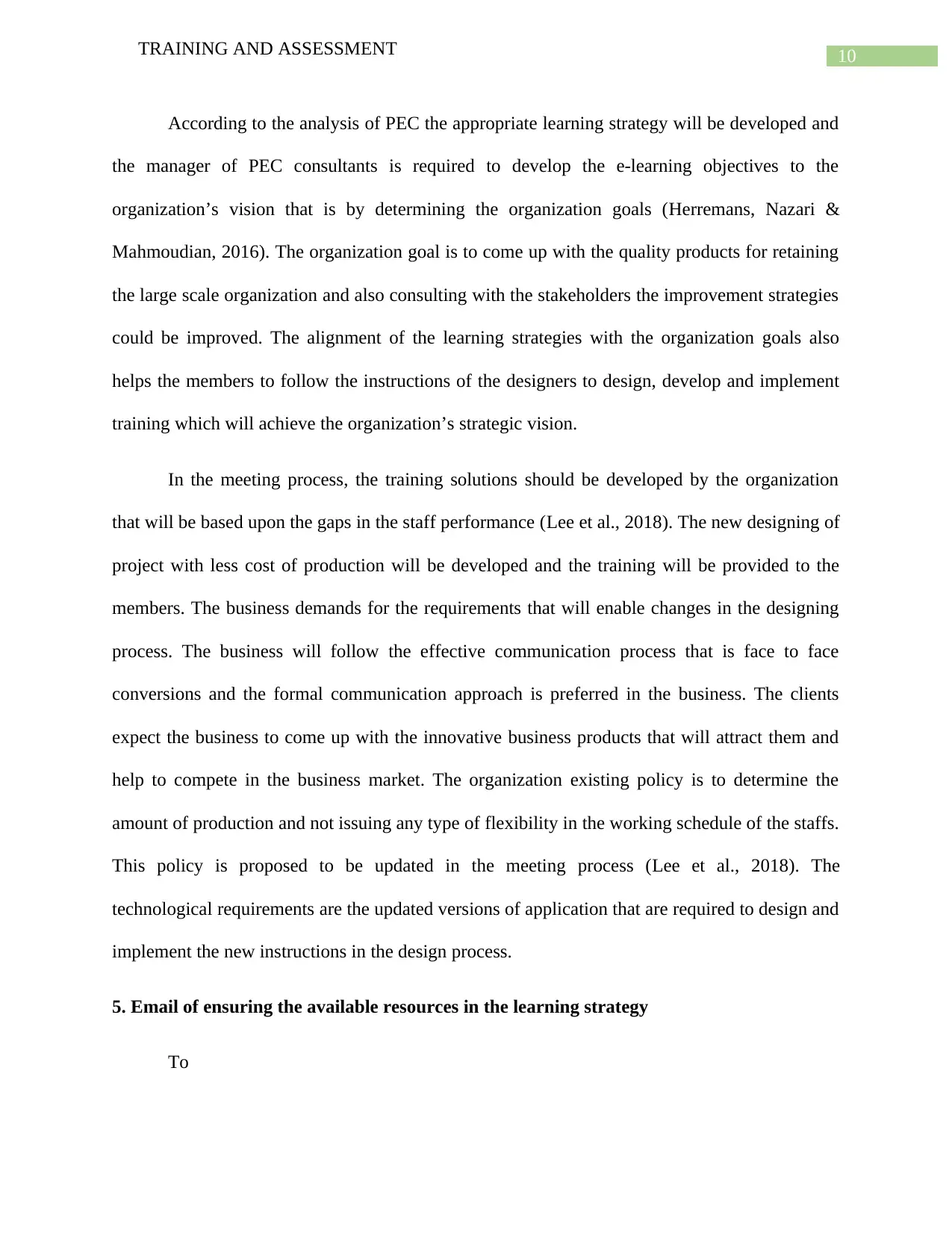
10TRAINING AND ASSESSMENT
According to the analysis of PEC the appropriate learning strategy will be developed and
the manager of PEC consultants is required to develop the e-learning objectives to the
organization’s vision that is by determining the organization goals (Herremans, Nazari &
Mahmoudian, 2016). The organization goal is to come up with the quality products for retaining
the large scale organization and also consulting with the stakeholders the improvement strategies
could be improved. The alignment of the learning strategies with the organization goals also
helps the members to follow the instructions of the designers to design, develop and implement
training which will achieve the organization’s strategic vision.
In the meeting process, the training solutions should be developed by the organization
that will be based upon the gaps in the staff performance (Lee et al., 2018). The new designing of
project with less cost of production will be developed and the training will be provided to the
members. The business demands for the requirements that will enable changes in the designing
process. The business will follow the effective communication process that is face to face
conversions and the formal communication approach is preferred in the business. The clients
expect the business to come up with the innovative business products that will attract them and
help to compete in the business market. The organization existing policy is to determine the
amount of production and not issuing any type of flexibility in the working schedule of the staffs.
This policy is proposed to be updated in the meeting process (Lee et al., 2018). The
technological requirements are the updated versions of application that are required to design and
implement the new instructions in the design process.
5. Email of ensuring the available resources in the learning strategy
To
According to the analysis of PEC the appropriate learning strategy will be developed and
the manager of PEC consultants is required to develop the e-learning objectives to the
organization’s vision that is by determining the organization goals (Herremans, Nazari &
Mahmoudian, 2016). The organization goal is to come up with the quality products for retaining
the large scale organization and also consulting with the stakeholders the improvement strategies
could be improved. The alignment of the learning strategies with the organization goals also
helps the members to follow the instructions of the designers to design, develop and implement
training which will achieve the organization’s strategic vision.
In the meeting process, the training solutions should be developed by the organization
that will be based upon the gaps in the staff performance (Lee et al., 2018). The new designing of
project with less cost of production will be developed and the training will be provided to the
members. The business demands for the requirements that will enable changes in the designing
process. The business will follow the effective communication process that is face to face
conversions and the formal communication approach is preferred in the business. The clients
expect the business to come up with the innovative business products that will attract them and
help to compete in the business market. The organization existing policy is to determine the
amount of production and not issuing any type of flexibility in the working schedule of the staffs.
This policy is proposed to be updated in the meeting process (Lee et al., 2018). The
technological requirements are the updated versions of application that are required to design and
implement the new instructions in the design process.
5. Email of ensuring the available resources in the learning strategy
To
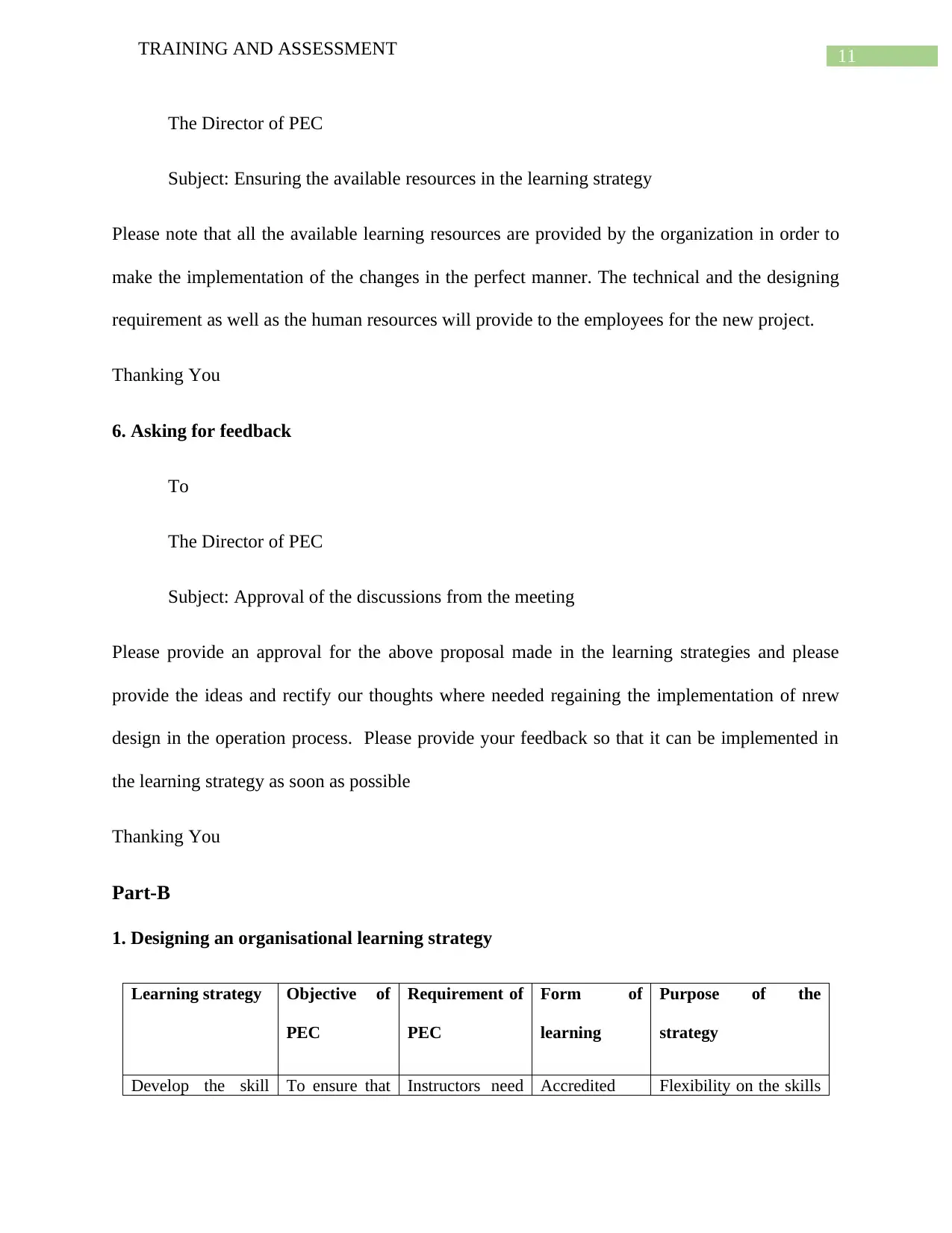
11TRAINING AND ASSESSMENT
The Director of PEC
Subject: Ensuring the available resources in the learning strategy
Please note that all the available learning resources are provided by the organization in order to
make the implementation of the changes in the perfect manner. The technical and the designing
requirement as well as the human resources will provide to the employees for the new project.
Thanking You
6. Asking for feedback
To
The Director of PEC
Subject: Approval of the discussions from the meeting
Please provide an approval for the above proposal made in the learning strategies and please
provide the ideas and rectify our thoughts where needed regaining the implementation of nrew
design in the operation process. Please provide your feedback so that it can be implemented in
the learning strategy as soon as possible
Thanking You
Part-B
1. Designing an organisational learning strategy
Learning strategy Objective of
PEC
Requirement of
PEC
Form of
learning
Purpose of the
strategy
Develop the skill To ensure that Instructors need Accredited Flexibility on the skills
The Director of PEC
Subject: Ensuring the available resources in the learning strategy
Please note that all the available learning resources are provided by the organization in order to
make the implementation of the changes in the perfect manner. The technical and the designing
requirement as well as the human resources will provide to the employees for the new project.
Thanking You
6. Asking for feedback
To
The Director of PEC
Subject: Approval of the discussions from the meeting
Please provide an approval for the above proposal made in the learning strategies and please
provide the ideas and rectify our thoughts where needed regaining the implementation of nrew
design in the operation process. Please provide your feedback so that it can be implemented in
the learning strategy as soon as possible
Thanking You
Part-B
1. Designing an organisational learning strategy
Learning strategy Objective of
PEC
Requirement of
PEC
Form of
learning
Purpose of the
strategy
Develop the skill To ensure that Instructors need Accredited Flexibility on the skills
⊘ This is a preview!⊘
Do you want full access?
Subscribe today to unlock all pages.

Trusted by 1+ million students worldwide
1 out of 27
Related Documents
Your All-in-One AI-Powered Toolkit for Academic Success.
+13062052269
info@desklib.com
Available 24*7 on WhatsApp / Email
![[object Object]](/_next/static/media/star-bottom.7253800d.svg)
Unlock your academic potential
Copyright © 2020–2025 A2Z Services. All Rights Reserved. Developed and managed by ZUCOL.



